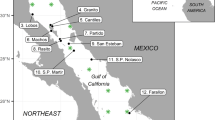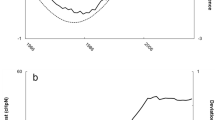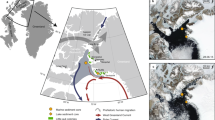Abstract
Climate change has been projected to affect species distribution1 and future trends of local populations2,3, but projections of global population trends are rare. We analyse global population trends of the emperor penguin (Aptenodytes forsteri), an iconic Antarctic top predator, under the influence of sea ice conditions projected by coupled climate models assessed in the Intergovernmental Panel on Climate Change (IPCC) effort4. We project the dynamics of all 45 known emperor penguin colonies5 by forcing a sea-ice-dependent demographic model6,7 with local, colony-specific, sea ice conditions projected through to the end of the twenty-first century. Dynamics differ among colonies, but by 2100 all populations are projected to be declining. At least two-thirds are projected to have declined by >50% from their current size. The global population is projected to have declined by at least 19%. Because criteria to classify species by their extinction risk are based on the global population dynamics8, global analyses are critical for conservation9. We discuss uncertainties arising in such global projections and the problems of defining conservation criteria for species endangered by future climate change.
This is a preview of subscription content, access via your institution
Access options
Subscribe to this journal
Receive 12 print issues and online access
$209.00 per year
only $17.42 per issue
Buy this article
- Purchase on Springer Link
- Instant access to full article PDF
Prices may be subject to local taxes which are calculated during checkout




Similar content being viewed by others
References
Thomas, C. D. et al. Extinction risk from climate change. Nature 427, 145–148 (2004).
Hunter, C. et al. Climate change threatens polar bear populations: A stochastic demographic analysis. Ecology 91, 2883–2897 (2010).
Jenouvrier, S. et al. Demographic models and IPCC climate projections predict the decline of an emperor penguin population. Proc. Natl Acad. Sci. USA 106, 1844–1847 (2009).
Meehl, G. et al. in IPCC Climate Change 2007: The Physical Science Basis (eds Solomon, S. et al.) (Cambridge Univ. Press, 2010).
Fretwell, P. T. et al. An emperor penguin population estimate: The first global, synoptic survey of a species from space. PLoS ONE 7, e33751 (2012).
Jenouvrier, S., Caswell, H., Barbraud, C. & Weimerskirch, H. Mating behavior, population growth, and the operational sex ratio: A periodic two-sex model approach. Am. Nat. 175, 739–752 (2010).
Jenouvrier, S. et al. Effects of climate change on an emperor penguin population: Analysis of coupled demographic and climate models. Glob. Change Biol. 18, 2756–2770 (2012).
IUCN Red List Categories and Criteria (International Union for Conservation of Nature, 2012).
Hannah, L. A global conservation system for climate-change adaptation. Conserv. Biol. 24, 70–77 (2010).
Trathan, P. N., Fretwell, P. T. & Stonehouse, B. First recorded loss of an emperor penguin colony in the recent period of Antarctic regional warming: Implications for other colonies. PLoS ONE 6, e14738 (2011).
Ainley, D. et al. Antarctic penguin response to habitat change as Earths troposphere reaches 2 degrees above preindustrial levels. Ecol. Monogr. 80, 49–66 (2010).
Fretwell, P. T., Trathan, P. N., Wienecke, B. & Kooyman, G. L. Emperor penguins breeding on iceshelves. PLoS ONE 9, e85285 (2014).
Loeb, V. et al. Effects of sea-ice extend and krill or salp dominance on the Antarctic food web. Nature 387, 897–900 (1997).
Barbraud, C. & Weimerskirch, H. Emperor penguins and climate change. Nature 411, 183–186 (2001).
Jenouvrier, S., Barbraud, C. & Weimerskirch, H. Long-term contrasted responses to climate of two Antarctic seabirds species. Ecology 86, 2889–2903 (2005).
Croxall, J., Trathan, P. & Murphy, E. Environmental change and Antarctic seabirds populations. Science 297, 1510–1514 (2002).
Wienecke, B. Review of historical population information of emperor penguins. Polar Biol. 34, 153–167 (2011).
Meehl, G. A. et al. The WCRP CMIP3 multi-model dataset: A new era in climate change research. Bull. Am. Meteorol. Soc. 88, 1383–1394 (2007).
Caswell, H., Fujiwara, M. & Brault, S. Declining survival probability threatens the North Atlantic right whale. Proc. Natl Acad. Sci. USA 96, 3308–3313 (1999).
Clark, J. S. Ecological forecasts: An emerging imperative. Science 293, 657–660 (2001).
Jenouvrier, S. Impacts of climate change on avian populations. Glob. Change Biol. 19, 2036–2057 (2013).
Caswell, H. Matrix Population Models (Sinauer, 2001).
Kooyman, G., Ainley, D., Ballard, G. & Ponganis, P. Effects of giant icebergs on two emperor penguin colonies in the Ross Sea, Antarctica. Antarct. Sci. 19, 31–38 (2007).
Reto, K. & Sedláček, J. Robustness and uncertainties in the new CMIP5 climate model projections. Nature Clim. Change 2, 1–5 (2012).
Solomon, S., Plattner, G-K., Knutti, R. & Friedlingstein, P. Irreversible climate change due to carbon dioxide emissions. Proc. Natl Acad. Sci. USA 106, 1704–1709 (2009).
Teng, H., Buja, L. E. & Meehl, G. A. Twenty-first-century climate change commitment from a multi-model ensemble. Geophys. Res. Lett. 33, L07706 (2006).
Ricke, K. L. & Caldeira, K. Natural climate variability and future climate policy. Nature Clim. Change 4, 333–338 (2014).
Nakicenovic, N. & Swart, R. (eds) in IPCC Special Report Emissions Scenarios (Intergovernmental Panel on Climate Change, 2000).
Acknowledgements
We acknowledge Institute Paul Emile Victor (Programme IPEV 109) and Terres Australes et Antarctiques Françaises for TA penguin data and the modelling groups Program for Climate Model Diagnosis and Intercomparison (PCMDI) and the WCRP’s Working Group on Coupled Modelling (WGCM) for sea ice data. S.J. acknowledges support from CIRES Visiting fellowships, WHOI Unrestricted funds, the Grayce B. Kerr Fund and the Penzance Endowed Fund in Support of Assistant Scientists and H.C. acknowledges support from NSF Grant DEB-1145017, the Alexander von Humboldt Foundation and ERC Advanced Grant 322989. We acknowledge D. Besson and K. Delord for TA penguin data management, P. Trathan and P. Fretwell for making satellite population counts available for earlier analysis and D. Ainley, L. Desvilettes and J. Garnier for fruitful discussions.
Author information
Authors and Affiliations
Contributions
This research was designed and coordinated by S.J., M.H., M.S., H.W. and H.C. Analyses were performed and coordinated by S.J. with the support of H.C. (demographic analysis), M.H. (climate models analysis), J.S. and M.S. (sea ice observations), C.B. and H.W. (emperor penguin observations). S.J. and H.C. contributed new analytic tools. Figures were created by S.J. (emperor penguin projections) and M.H. (sea ice maps). S.J., M.H. and H.C. wrote the paper. J.S., M.S., C.B. and H.W. contributed equally to the study. All authors discussed the results and commented on the manuscript.
Corresponding authors
Ethics declarations
Competing interests
The authors declare no competing financial interests.
Supplementary information
Rights and permissions
About this article
Cite this article
Jenouvrier, S., Holland, M., Stroeve, J. et al. Projected continent-wide declines of the emperor penguin under climate change. Nature Clim Change 4, 715–718 (2014). https://doi.org/10.1038/nclimate2280
Received:
Accepted:
Published:
Issue Date:
DOI: https://doi.org/10.1038/nclimate2280
This article is cited by
-
Using telemetry data and the sea ice satellite record to identify vulnerabilities in critical moult habitat for emperor penguins in West Antarctica
Polar Biology (2024)
-
Projections of winter polynyas and their biophysical impacts in the Ross Sea Antarctica
Climate Dynamics (2024)
-
Record low 2022 Antarctic sea ice led to catastrophic breeding failure of emperor penguins
Communications Earth & Environment (2023)
-
A review of the scientific knowledge of the seascape off Dronning Maud Land, Antarctica
Polar Biology (2022)
-
Contrasting responses to a climate regime change by sympatric, ice-dependent predators
BMC Evolutionary Biology (2016)



